A) ![]()
B) ![]()
C) 7 ![]()
D) −7 ![]()
E) ![]()
Correct Answer

verified
Correct Answer
verified
Short Answer
A regulation basketball has a 25.0-cm diameter and a mass of 0.560 kg.It may be approximated as a thin spherical shell with a moment of inertia  MR2.Starting from rest,how long will it take a basketball to roll without slipping 4.00 m down an incline at 30.0° to the horizontal?
MR2.Starting from rest,how long will it take a basketball to roll without slipping 4.00 m down an incline at 30.0° to the horizontal?
Correct Answer

verified
Correct Answer
verified
Multiple Choice
The diagram below shows five thin cylindrical shells,each shell rotating with constant angular velocity about its central axis.The magnitude of the tangential speed of one point of each cylinder is shown,along with each cylinder's radius and mass.Which cylindrical shell has the largest angular momentum?
A) ![]()
B) ![]()
C) ![]()
D) ![]()
E) ![]()
Correct Answer

verified
Correct Answer
verified
Multiple Choice
Two vectors lying in the xy plane are given by the equations  And
And  ) The value of
) The value of  Is
Is
A) 19 ![]()
B) −11 ![]()
C) −19 ![]()
D) 11 ![]()
E) 10 ![]()
Correct Answer

verified
Correct Answer
verified
Multiple Choice
A massless rope is wrapped around a uniform cylinder that has radius R and mass M,as shown in the figure.Initially,the unwrapped portion of the rope is vertical and the cylinder is horizontal.The linear acceleration of the cylinder is 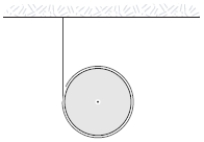
A) (2/3) g
B) (1/2) g
C) (1/3) g
D) (1/6) g
E) (5/6) g
Correct Answer

verified
Correct Answer
verified
Multiple Choice
The diagram below shows five 20-kg rods of the same 2.0-m length free to rotate about axes through the rods,as indicated.Which rod experiences the greatest magnitude gravitational torque?
A) ![]()
B) ![]()
C) ![]()
D) ![]()
E) ![]()
Correct Answer

verified
Correct Answer
verified
Multiple Choice
In the figure,a 1.6-kg weight swings in a vertical circle at the end of a string having negligible weight.The string is 2 m long.If the weight is released with zero initial velocity from a horizontal position,its angular momentum (in kg⋅m2/s) at the lowest point of its path relative to the center of the circle is approximately 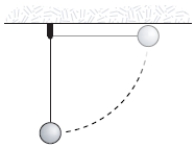
A) 40
B) 10
C) 30
D) 20
E) 50
Correct Answer

verified
Correct Answer
verified
Multiple Choice
A 0.5 kg fish,hooked as shown below,starts to swim away at a speed of 3 m/s.The angular momentum of the fish relative to the hand holding the fishing rod is about 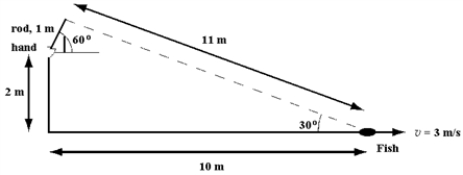
A) ![]() .
.
B) ![]() .
.
C) ![]() .
.
D) ![]() .
.
E) ![]() .
.
Correct Answer

verified
Correct Answer
verified
Multiple Choice
Five identical cylinders are each acted on by forces of equal magnitude.Which force exerts the biggest torque about the central axes of the cylinders?
A) ![]()
B) ![]()
C) ![]()
D) ![]()
E) ![]()
Correct Answer

verified
Correct Answer
verified
Multiple Choice
Two objects of mass m1 = 2m and m2 = m move around a rotation axis A in parallel circles of radii r1 = r and r2 = 2r with equal tangential speeds.As they rotate,forces of equal magnitude are applied opposite to their velocities to stop them.Which statement is correct? 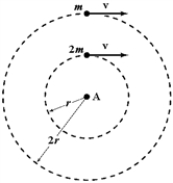
A) m2 will stop first because it has the larger initial angular velocity.
B) m1 will stop first because it has the smaller radius.
C) m2 will stop first because the torque on it is greater.
D) m1 will stop first because it has the smaller moment of inertia.
E) Both objects will stop at the same time because the angular accelerations are equal.
Correct Answer

verified
Correct Answer
verified
Multiple Choice
Two blocks,m1 = 1.0 kg and m2 = 2.0 kg,are connected by a light string as shown in the figure.If the radius of the pulley is 1.0 m and its moment of inertia is 5.0 kg⋅m2,the acceleration of the system is 
A) (1/6) g
B) (3/8) g
C) (1/8) g
D) (1/2) g
E) (5/8) g
Correct Answer

verified
Correct Answer
verified
Multiple Choice
A puck on a frictionless air hockey table has a mass of 5.0 g and is attached to a cord passing through a hole in the surface as in the figure.The puck is revolving at a distance 2.0 m from the hole with an angular velocity of 3.0 rad/s.The cord is then pulled from below,shortening the radius to 1.0 m.The new angular velocity (in rad/s) is 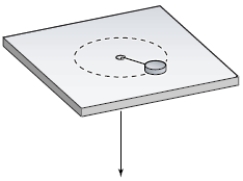
A) 4.0
B) 6.0
C) 12
D) 2.0
E) 8.0
Correct Answer

verified
Correct Answer
verified
Multiple Choice
A skater extends her arms horizontally,holding a 5-kg mass in each hand.She is rotating about a vertical axis with an angular velocity of one revolution per second.If she drops her hands to her sides,what will the final angular velocity (in rev/s) be if her moment of inertia remains approximately constant at 5 kg⋅m2,and the distance of the masses from the axis changes from 1 m to 0.1 m?
A) 6
B) 3
C) 9
D) 4
E) 7
Correct Answer

verified
Correct Answer
verified
Multiple Choice
A pendulum bob of mass m is set into motion in a circular path in a horizontal plane as shown in the figure.The square of the angular momentum of the bob about the vertical axis through the point P is 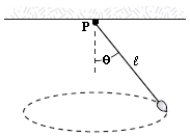
A) m2 gl3 sin4 θ/cos θ
B) m2 gl3 sin3 θ/cos θ
C) m2 gl3 sin2 θ/cos θ
D) m2 gl3 sin θ/cos θ
E) m2 gl3 sin2 θ
Correct Answer

verified
Correct Answer
verified
Multiple Choice
If L represents angular momentum,I represents moment of inertia,p represents linear momentum,m represents mass,and r represents a distance,which of the following can represent kinetic energy?
A) p2/2m
B) L2/2I
C) rpI
D) all of the above
E) both (a) and (b)
Correct Answer

verified
Correct Answer
verified
Multiple Choice
The diagram below shows five cylinders,each cylinder rotating with constant angular velocity about its central axis.The magnitude of the tangential speed of one point of each cylinder is shown,along with each cylinder's radius and mass.Which cylinder has the largest angular momentum?
A) ![]()
B) ![]()
C) ![]()
D) ![]()
E) ![]()
Correct Answer

verified
Correct Answer
verified
Multiple Choice
A top is set spinning so that the rotation is counterclockwise around its axis when viewed from above.When the top is placed on a level surface it happens that its axis of rotation is not quite vertical.Viewed from above,which way does the rotational axis of the top precess?
A) clockwise
B) counterclockwise
C) It's random,if it starts clockwise it will continue clockwise,and vice versa,i.e.,a 50% chance either way.
D) The direction depends on the little shove given to the axis when the top is placed on the surface.
E) In the northern hemisphere it will be clockwise,in the southern hemisphere it will be counterclockwise.
Correct Answer

verified
Correct Answer
verified
Multiple Choice
A solid cylinder of radius R = 1.0 m and mass 10 kg rotates about its axis.When its angular velocity is 10 rad/s,its angular momentum (in kg⋅m2/s) is
A) 50.
B) 20.
C) 40.
D) 25.
E) 70.
Correct Answer

verified
Correct Answer
verified
Multiple Choice
A particle whose mass is 2 kg moves in the xy plane with a constant speed of 3 m/s along the direction  ) What is its angular momentum (in kg�⋅m2/s) relative to the origin?
) What is its angular momentum (in kg�⋅m2/s) relative to the origin?
A) 0 ![]()
B) ![]()
C) ![]()
D) 6 ![]()
E) −6 ![]()
Correct Answer

verified
Correct Answer
verified
Multiple Choice
A thin rod of mass M and length L is struck at one end by a ball of clay of mass m,moving with speed v as shown in the figure.The ball sticks to the rod.After the collision,the angular momentum of the clay-rod system about A,the midpoint of the rod,is 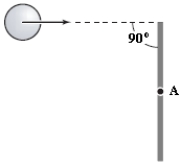
A) (m + M/3) (vL/2)
B) (m + M/12) (vL/2)
C) (m + M/6) (vL/2)
D) mvL/2
E) mvL
Correct Answer

verified
Correct Answer
verified
Showing 21 - 40 of 46
Related Exams